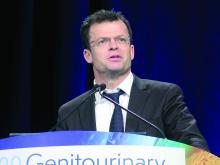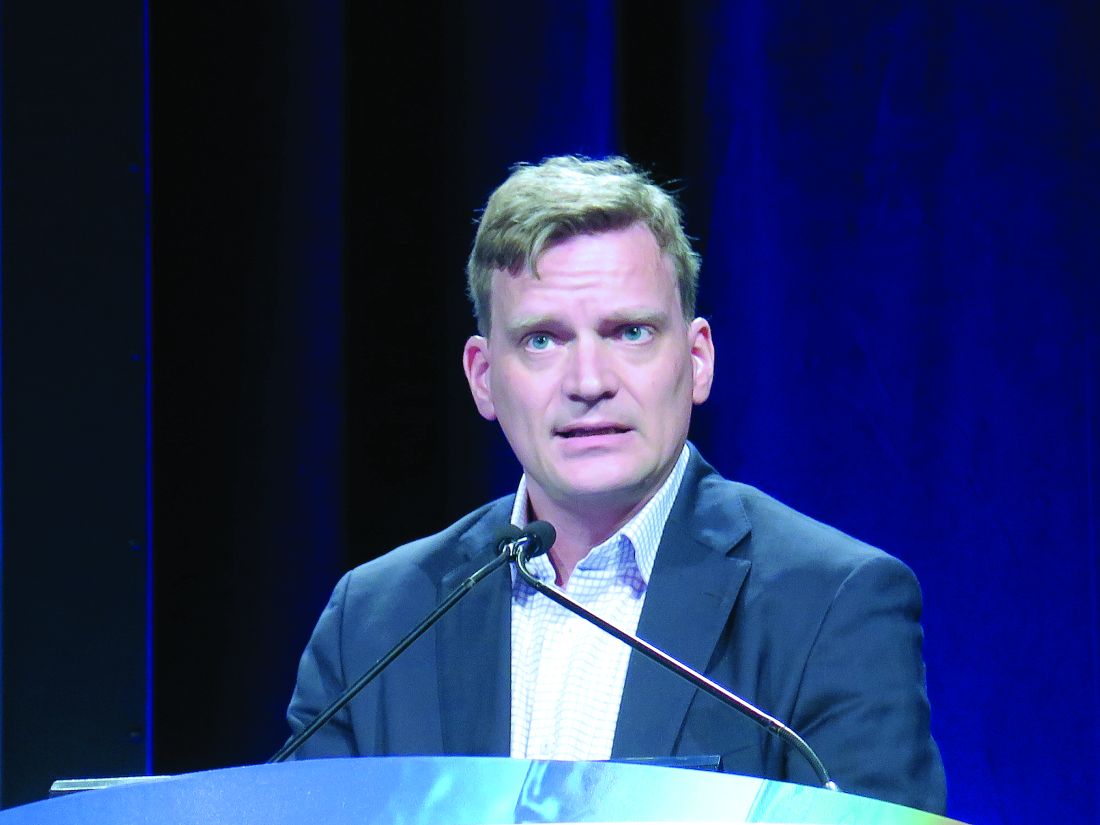User login
SAN FRANCISCO – (RCC), results of the RADVAX RCC trial suggest.
More than half of patients (56%) who received SBRT plus nivolumab and ipilimumab achieved a response in nonirradiated lesions, but the prespecified threshold for efficacy was not met (70%). Still, the combination was active and well tolerated, and it warrants further investigation, according to Hans J. Hammers, MD, PhD, of the University of Texas, Dallas.
Dr. Hammers presented results from the RADVAX RCC trial at the 2020 Genitourinary Cancers Symposium sponsored by the American Society for Clinical Oncology, ASTRO, and the Society of Urologic Oncology.
Study details
The phase 2 trial enrolled 25 patients with metastatic clear-cell RCC. They had at least two metastatic sites, one of which was measurable for response. Forty percent had received at least one prior line of systemic therapy, and 30% had tumors positive for programmed death–ligand 1 expression. Almost a third had not undergone nephrectomy and therefore still had their primary tumor.
Patients received SBRT (50 Gy in five fractions) at one or two sites while also receiving nivolumab and ipilimumab. SBRT was given right after the first of four nivolumab-ipilimumab treatments and was delivered to lesions in the lung (56% of patients), lymph nodes (20%), bone or soft tissue (12%), and kidney (12%). Patients went on to receive maintenance nivolumab monotherapy.
At a median follow-up of 24 months, 56% of patients achieved a response in nonirradiated lesions. All were partial responses.
The 56% response rate fell short of the trial’s predefined efficacy endpoint of 70%. However, “we felt that an increase to around 60% [with the addition of SBRT] would probably be a reasonable signal for this small signal-finding study,” Dr. Hammers said, noting that this would be in line with the increase seen with intratumoral injections of immune stimulators.
“I would say we are not that far off if the numbers are real,” he added. “That certainly needs to be confirmed and expanded. And I’m sure we can make it more intelligent by choosing which tumors we go after because, right now, we are doing it completely blindly.”
The lack of any complete responses is likely explained, in part, by the large share of patients still having their primary tumor, Dr. Hammers said.
The median duration of response was not reached. The median progression-free survival was 8.21 months, and the median overall survival was not reached.
Thirty-six percent of patients experienced grade 3-4 adverse events, all gastrointestinal. Of the two patients (8%) experiencing grade 2 radiation pneumonitis, one was a case of radiation recall. Some patients needed high-dose corticosteroids (40%) and additional immune suppression (28%) for side effect management.
Should SBRT move forward in RCC?
“We feel that the combination of SBRT with dual immune checkpoint inhibition is feasible and associated with an acceptable safety profile,” Dr. Hammers said. “We do see an encouraging antitumor activity that we believe warrants further investigation.”
A proposed RADVAX II trial would assess programmed death–ligand 1 expression across tumor sites using PET. “We would then direct the radiation to the cold [noninflamed] tumors to derive potentially the maximum benefit in the sense of in situ vaccination,” Dr. Hammers explained.
Invited discussant Thomas Powles, MD, PhD, of the Barts Cancer Institute in London, questioned whether SBRT plus immunotherapy should move forward in RCC patients. He noted that the abscopal effect was first described in the 1950s, but evidence of its clinical efficacy remains limited and inconsistent.
“We are in an era where we are keen to believe that this [phenomenon] exists,” Dr. Powles said. “But just because we can do SBRT in our hospitals doesn’t mean we should be doing it without robust data. The robustness of this data in renal cancer is not there at the moment.”
The 56% response rate seen in the RADVAX RCC trial was somewhat better than the 42% response rate seen in the CheckMate 214 trial with nivolumab and ipilimumab alone among patients with metastatic RCC treated in the first-line setting (Lancet Oncol. 2019;20:1370-85), Dr. Powles noted, while acknowledging the limitations of a cross-trial comparison.
“[However,] there were no complete responses, and this is therefore not a home run, in my opinion,” he said. “Progression-free survival was modest. Clearly, tolerability was okay.”
“In this work, the null hypothesis has not been rejected,” he added. “That’s an English way of saying it didn’t work very well. The question I put to you is, if [SBRT and immunotherapy] were a drug combination, would we be taking it further in randomized trials? And I suspect the answer to that is probably no.”
This trial was funded by KidneyCAN. Dr. Hammers and Dr. Powles disclosed relationships with Bristol-Myers Squibb, which markets nivolumab and ipilimumab, as well as other companies.
SOURCE: Hammers HJ et al. GUCS 2020, Abstract 614.
SAN FRANCISCO – (RCC), results of the RADVAX RCC trial suggest.
More than half of patients (56%) who received SBRT plus nivolumab and ipilimumab achieved a response in nonirradiated lesions, but the prespecified threshold for efficacy was not met (70%). Still, the combination was active and well tolerated, and it warrants further investigation, according to Hans J. Hammers, MD, PhD, of the University of Texas, Dallas.
Dr. Hammers presented results from the RADVAX RCC trial at the 2020 Genitourinary Cancers Symposium sponsored by the American Society for Clinical Oncology, ASTRO, and the Society of Urologic Oncology.
Study details
The phase 2 trial enrolled 25 patients with metastatic clear-cell RCC. They had at least two metastatic sites, one of which was measurable for response. Forty percent had received at least one prior line of systemic therapy, and 30% had tumors positive for programmed death–ligand 1 expression. Almost a third had not undergone nephrectomy and therefore still had their primary tumor.
Patients received SBRT (50 Gy in five fractions) at one or two sites while also receiving nivolumab and ipilimumab. SBRT was given right after the first of four nivolumab-ipilimumab treatments and was delivered to lesions in the lung (56% of patients), lymph nodes (20%), bone or soft tissue (12%), and kidney (12%). Patients went on to receive maintenance nivolumab monotherapy.
At a median follow-up of 24 months, 56% of patients achieved a response in nonirradiated lesions. All were partial responses.
The 56% response rate fell short of the trial’s predefined efficacy endpoint of 70%. However, “we felt that an increase to around 60% [with the addition of SBRT] would probably be a reasonable signal for this small signal-finding study,” Dr. Hammers said, noting that this would be in line with the increase seen with intratumoral injections of immune stimulators.
“I would say we are not that far off if the numbers are real,” he added. “That certainly needs to be confirmed and expanded. And I’m sure we can make it more intelligent by choosing which tumors we go after because, right now, we are doing it completely blindly.”
The lack of any complete responses is likely explained, in part, by the large share of patients still having their primary tumor, Dr. Hammers said.
The median duration of response was not reached. The median progression-free survival was 8.21 months, and the median overall survival was not reached.
Thirty-six percent of patients experienced grade 3-4 adverse events, all gastrointestinal. Of the two patients (8%) experiencing grade 2 radiation pneumonitis, one was a case of radiation recall. Some patients needed high-dose corticosteroids (40%) and additional immune suppression (28%) for side effect management.
Should SBRT move forward in RCC?
“We feel that the combination of SBRT with dual immune checkpoint inhibition is feasible and associated with an acceptable safety profile,” Dr. Hammers said. “We do see an encouraging antitumor activity that we believe warrants further investigation.”
A proposed RADVAX II trial would assess programmed death–ligand 1 expression across tumor sites using PET. “We would then direct the radiation to the cold [noninflamed] tumors to derive potentially the maximum benefit in the sense of in situ vaccination,” Dr. Hammers explained.
Invited discussant Thomas Powles, MD, PhD, of the Barts Cancer Institute in London, questioned whether SBRT plus immunotherapy should move forward in RCC patients. He noted that the abscopal effect was first described in the 1950s, but evidence of its clinical efficacy remains limited and inconsistent.
“We are in an era where we are keen to believe that this [phenomenon] exists,” Dr. Powles said. “But just because we can do SBRT in our hospitals doesn’t mean we should be doing it without robust data. The robustness of this data in renal cancer is not there at the moment.”
The 56% response rate seen in the RADVAX RCC trial was somewhat better than the 42% response rate seen in the CheckMate 214 trial with nivolumab and ipilimumab alone among patients with metastatic RCC treated in the first-line setting (Lancet Oncol. 2019;20:1370-85), Dr. Powles noted, while acknowledging the limitations of a cross-trial comparison.
“[However,] there were no complete responses, and this is therefore not a home run, in my opinion,” he said. “Progression-free survival was modest. Clearly, tolerability was okay.”
“In this work, the null hypothesis has not been rejected,” he added. “That’s an English way of saying it didn’t work very well. The question I put to you is, if [SBRT and immunotherapy] were a drug combination, would we be taking it further in randomized trials? And I suspect the answer to that is probably no.”
This trial was funded by KidneyCAN. Dr. Hammers and Dr. Powles disclosed relationships with Bristol-Myers Squibb, which markets nivolumab and ipilimumab, as well as other companies.
SOURCE: Hammers HJ et al. GUCS 2020, Abstract 614.
SAN FRANCISCO – (RCC), results of the RADVAX RCC trial suggest.
More than half of patients (56%) who received SBRT plus nivolumab and ipilimumab achieved a response in nonirradiated lesions, but the prespecified threshold for efficacy was not met (70%). Still, the combination was active and well tolerated, and it warrants further investigation, according to Hans J. Hammers, MD, PhD, of the University of Texas, Dallas.
Dr. Hammers presented results from the RADVAX RCC trial at the 2020 Genitourinary Cancers Symposium sponsored by the American Society for Clinical Oncology, ASTRO, and the Society of Urologic Oncology.
Study details
The phase 2 trial enrolled 25 patients with metastatic clear-cell RCC. They had at least two metastatic sites, one of which was measurable for response. Forty percent had received at least one prior line of systemic therapy, and 30% had tumors positive for programmed death–ligand 1 expression. Almost a third had not undergone nephrectomy and therefore still had their primary tumor.
Patients received SBRT (50 Gy in five fractions) at one or two sites while also receiving nivolumab and ipilimumab. SBRT was given right after the first of four nivolumab-ipilimumab treatments and was delivered to lesions in the lung (56% of patients), lymph nodes (20%), bone or soft tissue (12%), and kidney (12%). Patients went on to receive maintenance nivolumab monotherapy.
At a median follow-up of 24 months, 56% of patients achieved a response in nonirradiated lesions. All were partial responses.
The 56% response rate fell short of the trial’s predefined efficacy endpoint of 70%. However, “we felt that an increase to around 60% [with the addition of SBRT] would probably be a reasonable signal for this small signal-finding study,” Dr. Hammers said, noting that this would be in line with the increase seen with intratumoral injections of immune stimulators.
“I would say we are not that far off if the numbers are real,” he added. “That certainly needs to be confirmed and expanded. And I’m sure we can make it more intelligent by choosing which tumors we go after because, right now, we are doing it completely blindly.”
The lack of any complete responses is likely explained, in part, by the large share of patients still having their primary tumor, Dr. Hammers said.
The median duration of response was not reached. The median progression-free survival was 8.21 months, and the median overall survival was not reached.
Thirty-six percent of patients experienced grade 3-4 adverse events, all gastrointestinal. Of the two patients (8%) experiencing grade 2 radiation pneumonitis, one was a case of radiation recall. Some patients needed high-dose corticosteroids (40%) and additional immune suppression (28%) for side effect management.
Should SBRT move forward in RCC?
“We feel that the combination of SBRT with dual immune checkpoint inhibition is feasible and associated with an acceptable safety profile,” Dr. Hammers said. “We do see an encouraging antitumor activity that we believe warrants further investigation.”
A proposed RADVAX II trial would assess programmed death–ligand 1 expression across tumor sites using PET. “We would then direct the radiation to the cold [noninflamed] tumors to derive potentially the maximum benefit in the sense of in situ vaccination,” Dr. Hammers explained.
Invited discussant Thomas Powles, MD, PhD, of the Barts Cancer Institute in London, questioned whether SBRT plus immunotherapy should move forward in RCC patients. He noted that the abscopal effect was first described in the 1950s, but evidence of its clinical efficacy remains limited and inconsistent.
“We are in an era where we are keen to believe that this [phenomenon] exists,” Dr. Powles said. “But just because we can do SBRT in our hospitals doesn’t mean we should be doing it without robust data. The robustness of this data in renal cancer is not there at the moment.”
The 56% response rate seen in the RADVAX RCC trial was somewhat better than the 42% response rate seen in the CheckMate 214 trial with nivolumab and ipilimumab alone among patients with metastatic RCC treated in the first-line setting (Lancet Oncol. 2019;20:1370-85), Dr. Powles noted, while acknowledging the limitations of a cross-trial comparison.
“[However,] there were no complete responses, and this is therefore not a home run, in my opinion,” he said. “Progression-free survival was modest. Clearly, tolerability was okay.”
“In this work, the null hypothesis has not been rejected,” he added. “That’s an English way of saying it didn’t work very well. The question I put to you is, if [SBRT and immunotherapy] were a drug combination, would we be taking it further in randomized trials? And I suspect the answer to that is probably no.”
This trial was funded by KidneyCAN. Dr. Hammers and Dr. Powles disclosed relationships with Bristol-Myers Squibb, which markets nivolumab and ipilimumab, as well as other companies.
SOURCE: Hammers HJ et al. GUCS 2020, Abstract 614.
REPORTING FROM GUCS 2020


